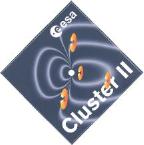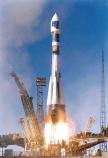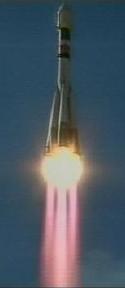Cluster

 The joint ESA-NASA Cluster II mission is to study, in three dimensions, the small-scale structures of the Earth's plasma environment. While the original Cluster mission was lost on June 4, 1996, due to an expolsion of the Ariane-5 test flight, the ESA's Science Program Committee approved on April 5, 1997 the reflight of the full mission by mid-2000.
The joint ESA-NASA Cluster II mission is to study, in three dimensions, the small-scale structures of the Earth's plasma environment. While the original Cluster mission was lost on June 4, 1996, due to an expolsion of the Ariane-5 test flight, the ESA's Science Program Committee approved on April 5, 1997 the reflight of the full mission by mid-2000.
The Cluster II mission consists of four identical spacecraft flying in formation between 19000 and 119000 km above the Earth. There, they will study the plasmas and fields of the magnetosphere and the solar wind in three dimensions. (From the ESA Cluster II site.)
The latest news:
- The composition "Rock
Around the Bow Shock" has
been computer-generated from data obtained during several consecutive crossings
of the Cluster spacecraft through the Bow Shock. Data sonification by Marty Quinn.
- Cluster Special Issue of Annales Geophysicae
- Surfing and diving in the Earth's magnetosphere, Cluster celebrates one year of science excellence in orbit. Space scientists around the world are today celebrating the first anniversary of the European Space Agency's revolutionary Cluster mission to explore near-Earth space and study the interaction between the Sun and Earth.
- Next Cluster meeting is from October 15-19, 2001, at CESR in Toulouse. Visit the site for information on the preliminary program, the workshop organisation, CESR and Hotels. Also online: the Registration Form; whether you will attend the meeting or not, this form will allow you to get a user account (name/passwd for ftp r/w access) and partcipate in the workshop forum and data exchange
-
UNH Space Instrument Gets Zapped by Solar Storm 25 April 2001
Link to: ESA's latest Cluster news
8th CLUSTER Workshop at UNH on Sept.
29 - Oct. 1, 2004
UNH Instrument Participation:
Cluster CODIF --- Cluster EDI
About the Cluster II Mission:
 4 Satellites Fly in Formation: 4 Satellites Fly in Formation:
- Purpose and Capabilities of Cluster:
The interaction of the Earth's magnetic field with the solar wind, a continuous but variable supersonic flow of particles from the Sun, creates a highly structured near-Earth environment. This local environment is called the magnetosphere. Its internal boundaries and contents change location and shape in a highly dynamic way in response to changes in the solar wind. Although much has been learned about the Earth's magnetosphere, data from single spacecraft have the limitation that spatial and temporal information cannot be separated. The Cluster mission will be the first mission to fly four identical spacecraft in a roughly pyramidal configuration with the goal of clearly separating spatial and temporal changes in the measurements. They will make simultaneous observations of particles and electromagnetic fields in this environment at separations of a few hundred km in the first year and a few thousand km in the later years. They will enhance our understanding of the Sun-Earth connections and of fundamental processes important at distant astrophysical objects, such as production and transport of energetic radiation.
- Photograph of 4 Cluster Satellites:
The four identical Cluster spacecraft each carry 11 instruments and weigh 1200 kg. They have been built by a consortium of European aerospace businesses under the direction of Dornier in Friedrichshafen, Germany.
- Project Overview and History of Cluster:
Cluster is one of two solar-terrestrial projects of international collaboration between the European Space Agency (ESA) and NASA. The other is the Solar and Heliospheric Observatory (SOHO) to study the Sun. Both Cluster and SOHO together form the first cornerstone mission of ESA's long term program. After the original proposals from the scientific community in 1983 their implementation started in 1988. Cluster and SOHO will operate in concert with Geotail, Wind and Polar to provide coordinated measurements through the entire geospace environment.
| Launch of Soyuz/Cluster |

|
| Two of four Cluster spacecraft are launched into orbit by a Soyuz rocket from Baikonur. |
What Do We Learn? (Examples)
- Shock structure
- Magnetic reconnection
- Add piece to the global view of the Earth's magnetosphere with other GGS spacecraft
Ahead Lies Detailed Data Analysis!!
- The wealth of data from Cluster will keep UNH Faculty, Research Scientists and Students busy for many years and will appear in a number Ph.D. theses and journal articles.
Other relevant links:
|

 The joint ESA-NASA Cluster II mission is to study, in three dimensions, the small-scale structures of the Earth's plasma environment. While the original Cluster mission was lost on June 4, 1996, due to an expolsion of the Ariane-5 test flight, the ESA's Science Program Committee approved on April 5, 1997 the reflight of the full mission by mid-2000.
The joint ESA-NASA Cluster II mission is to study, in three dimensions, the small-scale structures of the Earth's plasma environment. While the original Cluster mission was lost on June 4, 1996, due to an expolsion of the Ariane-5 test flight, the ESA's Science Program Committee approved on April 5, 1997 the reflight of the full mission by mid-2000.  4 Satellites Fly in Formation:
4 Satellites Fly in Formation: 